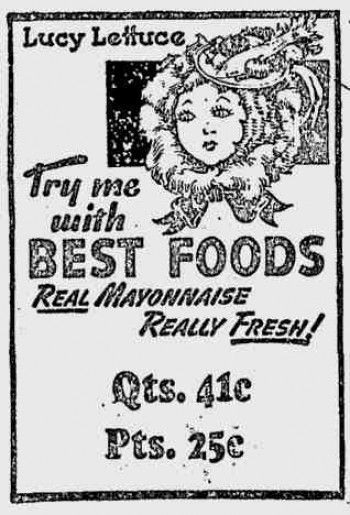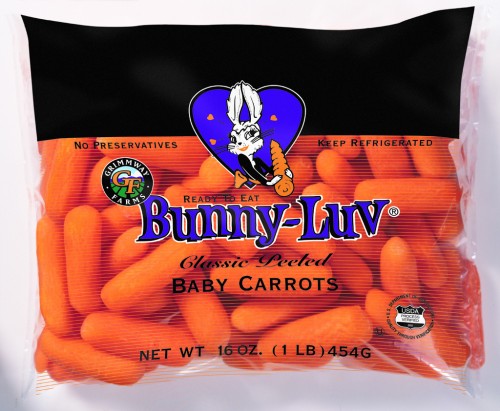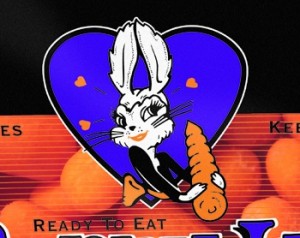Vegetables
Call Any Vegetable
I just relistened to Frank Zappa's 1971 album, Live at the Fillmore East, or, Freaks & Motherfu*#@%! for the first time in about 40 years, and marveled again at the visionary talents of this supreme musical weirdo. Of course, Zappa died too young at age 52, and we were deprived of many potential years of his music.
I thought this vegetable song might somewhat counterbalance all the bacon and meat talk on WU.
Posted By: Paul - Fri Feb 17, 2012 -
Comments (8)
Category: Anthropomorphism, Food, Vegetables, Humor, Surrealism, Bohemians, Beatniks, Hippies and Slackers, 1970s
Lucy Lettuce

Years ago I made a series of collages illustrating what I called "Lesser-Known Advertising Icons." The D List of product representatives. Here's another one I just found, pictured above.
For every Tony the Tiger, there are scores of Lucy Lettuces.
Original ad here.
Click on the link below the book cover image for a volume on the topic.
What a Character!: 20th Century American Advertising Icons
Posted By: Paul - Tue Feb 07, 2012 -
Comments (4)
Category: Anthropomorphism, Advertising, Books, Vegetables, 1940s
Ninja Broccoli

Posted By: Alex - Sat Jan 28, 2012 -
Comments (4)
Category: Food, Vegetables
How to burble a pea
How in the world did I reach the age of 43 without knowing that it was possible to burble a pea? Instructions can be found at askapastor.org:Or just watch one of these videos:
Posted By: Alex - Thu Jan 19, 2012 -
Comments (3)
Category: Food, Vegetables
Bunny Luv


Posted By: Paul - Tue Apr 26, 2011 -
Comments (3)
Category: Anthropomorphism, Business, Advertising, Vegetables
Another Helping of Food Related Weirdness – 7

Meanwhile, here is someone who is taking the chocolate maker’s art way too literally. Jean Zaun of Fredericksburg in Pennsylvania uses a mixture of dark and white chocolate, food colouring and confectioner’s glaze to recreate famous works of art, including the frames, in a deliciously edible form. Her subjects have included the works of Van Gogh, Munch and Da Vinci, as well as a portrait of Ozzy Osborne commissioned by his wife. While the chocolate artworks are edible, Zaun believes they should be souvenirs rather than snacks. “They are meant to be consumed by the eye, not the stomach.” Zaun Explained (Daily Mail).
And the misuse of materials won’t stop there, at least not if Dr. Peter Eisner of the Fraunhofer Institute gets his way. Concerned that meat consumption is both unhealthy and bad for the environment, Dr. Eisner has started looking for ways to supplement or replace animal products with vegetable equivalents. His first success is a milk substitute derived from lupins that can even be used to make cheese, meanwhile co-worker Daniela Sussmann has extracted a protein from the seeds gives low-fat sausages more of the sensation of their unadulterated competition. Eisner reckons that our ever growing appetite for meat could one day be disastrous, arguing that the resources needed to produce 1 kilo of meat could instead yield 80 to 100 kilos of fruit or vegetables (Softpedia).
More in extended >>
Posted By: Dumbfounded - Mon Jan 10, 2011 -
Comments (7)
Category: Agriculture, Animals, Farming, Art, Food, Bacon, Candy, Junk Food, Nutrition, Vegetables
Follies of the Mad Men #86
Posted By: Paul - Tue Feb 02, 2010 -
Comments (6)
Category: Business, Advertising, Products, Sexuality, Vegetables

| Who We Are |
|---|
| Alex Boese Alex is the creator and curator of the Museum of Hoaxes. He's also the author of various weird, non-fiction, science-themed books such as Elephants on Acid and Psychedelic Apes. Paul Di Filippo Paul has been paid to put weird ideas into fictional form for over thirty years, in his career as a noted science fiction writer. He has recently begun blogging on many curious topics with three fellow writers at The Inferior 4+1. Contact Us |




